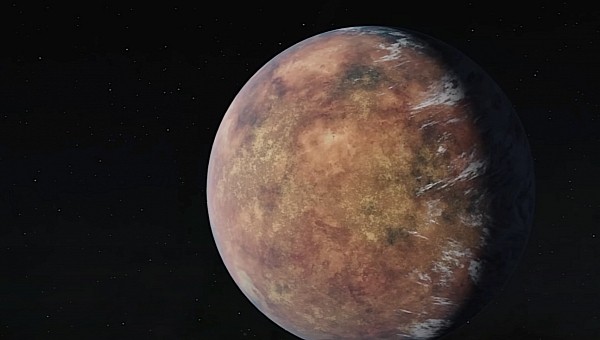As per NASA’s own admission, to date scientists around the world have pinpointed over 5,000 exoplanets in this great Universe of ours. Impressive as it is, it’s likely the number doesn’t even begin to scratch the surface of what’s out there, another proof that at least from a mathematical standpoint, there’s a big chance we’re not alone.
With the James Webb Space Telescope out and about, several other such pieces of hardware already in operation, and with the Roman Space Telescope just around the corner, it’s likely that number will increase rapidly over the coming years.
The current level of technological advancement of our civilization does not allow us to detect whether there is life of any kind on any of those planets, but we can detect if they’re located far (and at the same time close) enough to the Sun to support liquid water and other elements that can allow the existence of living creatures as we know them.
We call that area around a sun the Goldilocks Zone. Our own solar system has two planets there, our own Earth and Mars (some add Venus to the list, too), but as per scientists, systems with more than one planet in this zone are the exception, as far as they know, and not the rule.
This is why when a team from NASA’s JPL discovered a new rocky planet in a system’s Goldilocks Zone they were hyped. Not because they found it, but because it’s that system’s second Goldilocks Zone planet, and it’s also about the same size as Earth.
The system is called TOI 700, and it’s centered around a red dwarf star (meaning tiny compared to our Sun, and the coolest kind of star we know of) located 100 light-years away from Earth, in a constellation called Dorado.
Scientists knew there were planets around this star, more precisely three of them, unimaginatively called TOI 700 b, c, and d. TOI 700 d was discovered in 2020, and it’s right in the system’s habitable zone.
As you’re reading this, Seattle, Washington, is the place where astronomers have flocked for the 241st meeting of the American Astronomical Society, and it is there where JPL’s Emily Gilbert broke the news of another Goldilocks planet being discovered in TOI 700.
It’s called (also unimaginatively) TOI 700 e, is about 95 percent the size of Earth, ten percent smaller than its sibling, TOI 700 d, and “likely rocky.” Astronomers spotted it using the Transiting Exoplanet Survey Satellite (TESS), a telescope launched in 2018 and tasked with looking at large sectors of the sky for 27 days at a time, searching for signs of planets passing in front of their suns.
TOI 700 e is believed to require 28 days to orbit its star, and might be tidally locked, meaning it always has the same side facing the star – not a good indication of a place capable of supporting life as we know it, but then again life always finds a way…
The discovery is important because, as said, we don’t come across systems with multiple small, habitable-zone planets all that often, and it might also help us humans better understand how our own solar system evolved.
The current level of technological advancement of our civilization does not allow us to detect whether there is life of any kind on any of those planets, but we can detect if they’re located far (and at the same time close) enough to the Sun to support liquid water and other elements that can allow the existence of living creatures as we know them.
We call that area around a sun the Goldilocks Zone. Our own solar system has two planets there, our own Earth and Mars (some add Venus to the list, too), but as per scientists, systems with more than one planet in this zone are the exception, as far as they know, and not the rule.
This is why when a team from NASA’s JPL discovered a new rocky planet in a system’s Goldilocks Zone they were hyped. Not because they found it, but because it’s that system’s second Goldilocks Zone planet, and it’s also about the same size as Earth.
The system is called TOI 700, and it’s centered around a red dwarf star (meaning tiny compared to our Sun, and the coolest kind of star we know of) located 100 light-years away from Earth, in a constellation called Dorado.
Scientists knew there were planets around this star, more precisely three of them, unimaginatively called TOI 700 b, c, and d. TOI 700 d was discovered in 2020, and it’s right in the system’s habitable zone.
As you’re reading this, Seattle, Washington, is the place where astronomers have flocked for the 241st meeting of the American Astronomical Society, and it is there where JPL’s Emily Gilbert broke the news of another Goldilocks planet being discovered in TOI 700.
It’s called (also unimaginatively) TOI 700 e, is about 95 percent the size of Earth, ten percent smaller than its sibling, TOI 700 d, and “likely rocky.” Astronomers spotted it using the Transiting Exoplanet Survey Satellite (TESS), a telescope launched in 2018 and tasked with looking at large sectors of the sky for 27 days at a time, searching for signs of planets passing in front of their suns.
TOI 700 e is believed to require 28 days to orbit its star, and might be tidally locked, meaning it always has the same side facing the star – not a good indication of a place capable of supporting life as we know it, but then again life always finds a way…
The discovery is important because, as said, we don’t come across systems with multiple small, habitable-zone planets all that often, and it might also help us humans better understand how our own solar system evolved.










